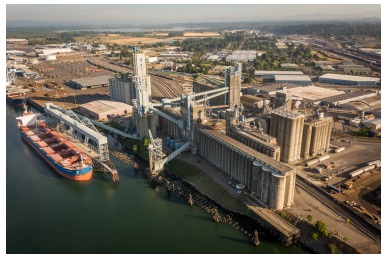Port Traffic Metrics: Oakland, Vancouver USA
![]() Print this Article | Send to Colleague
Print this Article | Send to Colleague
Oakland – Import Containers Jumped 19 Percent in March
Port of Oakland reports import cargo laden container traffic rebounded in March, jumping 19.1 from the year earlier total. That contrasts with the 9.2 percent decline posted in February and reflects a return to normal trade patterns following February Lunar New Year celebrations in Asia.
"This is a nice rebound," said Maritime Director John Driscoll. "We’re watching now to find out if it signals stronger trade growth for the rest of the year."
Last month’s data also shows increases from March 2016 of 2.4 percent for exports, 17.5 percent for empty containers and 11.2 percent in container trade overall (to 198,996 TEUs). Year-to-date throughput set a first-quarter record for Oakland of 571,208 TEUs.
The port notes that, 402 ships called in Oakland during the first three months of 2017. That was down 5.6 percent from a year ago. However, these ships carried an average of 8.4 percent more containers in and out of Oakland, reflecting the shipping industry’s effort to consolidate greater quantities of cargo on fewer vessels.
Port of Vancouver USA Cargo Tops 7.0 million Tons for First Time
Cargo throughput at the Port of Vancouver USA exceeded 7.0 million metric times for the first time ever in 2016. The year-end total of 7,488,469 tons exceeded the previous record high, 6,957,330 tons in 2015, by 7.6 percent. It was also Vancouver’s third consecutive year of tonnage increases.
Exports alone increased 14 percent to 6.3 million tons, including a 17.8 percent increase for grain, which remained the port’s dominant cargo by weight. Imports overall fell 17 percent despite gains by some cargo types such as wind energy components.
Despite the tonnage gains, fluctuations in currency and the global economy had an impact on the port in 2016, contributing to a slight decline in operating revenue, which decreased from $38.2 million to $35.9 million.
Leveraging revenue, federal and state grant funds and tax dollars, the port continues to invest in infrastructure and assets, including rail, equipment, buildings, dock improvements and skilled staff.
"These are the types of improvements that attract businesses to the port and help create jobs for the residents of Southwest Washington," said Port CEO Julianna Marler. "We continue to find cost-effective ways to invest in your public port, planning for the future and working with our customers and partners to make sure those jobs and economic benefit are here for the long-term."
Port of Oakland reports import cargo laden container traffic rebounded in March, jumping 19.1 from the year earlier total. That contrasts with the 9.2 percent decline posted in February and reflects a return to normal trade patterns following February Lunar New Year celebrations in Asia.
"This is a nice rebound," said Maritime Director John Driscoll. "We’re watching now to find out if it signals stronger trade growth for the rest of the year."
Last month’s data also shows increases from March 2016 of 2.4 percent for exports, 17.5 percent for empty containers and 11.2 percent in container trade overall (to 198,996 TEUs). Year-to-date throughput set a first-quarter record for Oakland of 571,208 TEUs.
The port notes that, 402 ships called in Oakland during the first three months of 2017. That was down 5.6 percent from a year ago. However, these ships carried an average of 8.4 percent more containers in and out of Oakland, reflecting the shipping industry’s effort to consolidate greater quantities of cargo on fewer vessels.
Port of Vancouver USA Cargo Tops 7.0 million Tons for First Time
Cargo throughput at the Port of Vancouver USA exceeded 7.0 million metric times for the first time ever in 2016. The year-end total of 7,488,469 tons exceeded the previous record high, 6,957,330 tons in 2015, by 7.6 percent. It was also Vancouver’s third consecutive year of tonnage increases.
Exports alone increased 14 percent to 6.3 million tons, including a 17.8 percent increase for grain, which remained the port’s dominant cargo by weight. Imports overall fell 17 percent despite gains by some cargo types such as wind energy components.
Despite the tonnage gains, fluctuations in currency and the global economy had an impact on the port in 2016, contributing to a slight decline in operating revenue, which decreased from $38.2 million to $35.9 million.
Leveraging revenue, federal and state grant funds and tax dollars, the port continues to invest in infrastructure and assets, including rail, equipment, buildings, dock improvements and skilled staff.
"These are the types of improvements that attract businesses to the port and help create jobs for the residents of Southwest Washington," said Port CEO Julianna Marler. "We continue to find cost-effective ways to invest in your public port, planning for the future and working with our customers and partners to make sure those jobs and economic benefit are here for the long-term."
The port is anticipating "solid numbers" in 2017 from such cargoes as autos, steel, minerals, wind energy components and grain.

Vancouver’s busy export grain terminal experienced a 17.8 percent jump in export tonnage in 2016
Photo/Port of Vancouver USA

